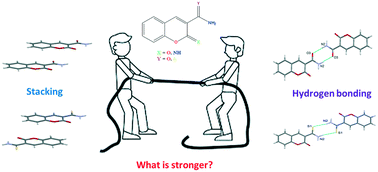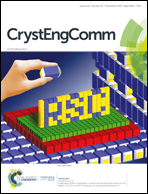Hydrogen bonding vs. stacking interaction in the crystals of the simplest coumarin derivatives: a study from the energetic viewpoint†
Abstract
The crystal structures of the carboxamide and thiocarboxamide derivatives of coumarin and 2-iminocoumarin have been studied thoroughly by comparing their pairwise interaction energies calculated by quantum chemistry methods. The crystals of coumarin-3-carboxamide and 2-iminocoumarin-3-carboxamide proved to be isostructural despite the predictable different properties of the carbonyl and imino groups in the formation of intermolecular interactions. The strongest interaction in these crystals is the N–H⋯O hydrogen bonds which form centrosymmetric dimers. Stacked columns of such dimers have been recognized as the main structural motif of columnar crystals of carboxamide derivatives. The weakening of the thiocarboxamide group acceptor properties as compared to those of the carboxamide group results in the close interaction energies of the hydrogen bonded and stacked dimers in the coumarin-3-thiocarboxamide crystal. Both these interactions form corrugated chains as the primary structural motif. The stacking interactions proved to be the strongest in the 2-iminocoumarin-3-thiocarboxamide crystal where they form stacked columns as the primary basic structural motif. The neighbouring chains interact stronger in two opposite directions forming layers as the secondary structural motif in both crystals of thiocarboxamide derivatives. These crystals have a columnar-layered structure.



 Please wait while we load your content...
Please wait while we load your content...